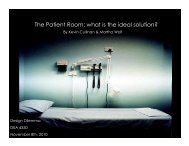The role of physical design and informal communication
The role of physical design and informal communication
The role of physical design and informal communication
Create successful ePaper yourself
Turn your PDF publications into a flip-book with our unique Google optimized e-Paper software.
increasing the potential <strong>of</strong> medication errors. However, the social interaction, while<br />
valuable for the above-mentioned reasons, poses the risk for medication errors when it<br />
occurs in abundance in the med room, as it did on 6N. Designers must ascertain a way<br />
to balance the need for supporting social interaction while at the same time limiting its<br />
potentially negative effect on performance <strong>and</strong> the quality <strong>of</strong> care.<br />
<strong>The</strong> second implication for practice regarding social interaction is that nurse<br />
managers <strong>and</strong> hospital administrators must redefine the culture <strong>of</strong> the nursing unit to<br />
include these <strong>informal</strong>, social interactions as “real work.” Becker (2007b) contends<br />
that if the organization’s perception <strong>of</strong> “real work” doesn’t include spontaneous,<br />
unplanned, opportunistic <strong>communication</strong>, then it will leave the organizational resource<br />
<strong>of</strong> <strong>informal</strong> knowledge networks untapped.<br />
4.6 Implications for Practice: Value <strong>of</strong> Observation<br />
On 6N, the data collection period coincided with the arrival <strong>of</strong> a new nurse<br />
manager. In order to better underst<strong>and</strong> the unit she was about to manage, the new<br />
nurse manager spent time observing 6N <strong>and</strong> discovered inefficiencies that stood in the<br />
way <strong>of</strong> the optimal functioning <strong>of</strong> the unit. According to staff, the changes that were<br />
made after observation had tremendous success, including fewer disruptions for nurses<br />
<strong>and</strong> doctors, unobstructed sightlines through the core <strong>of</strong> the unit, <strong>and</strong> more convenient<br />
access to information for visitors. <strong>The</strong> practical implication is that observation is a<br />
cheap, simple, <strong>and</strong> effective method for gaining insight into the operation <strong>of</strong> the unit<br />
as a system. Existing hospitals that have tight budgets yet are interested in improving<br />
operational efficiency can use observation as a tool to discover problems. Managers<br />
<strong>and</strong> administrators may very well find that there are simple, relatively inexpensive<br />
solutions to these problems that can have significant positive results, as was the case<br />
on 6N. <strong>The</strong> idea that increasing operational efficiency is a costly endeavor that<br />
115







